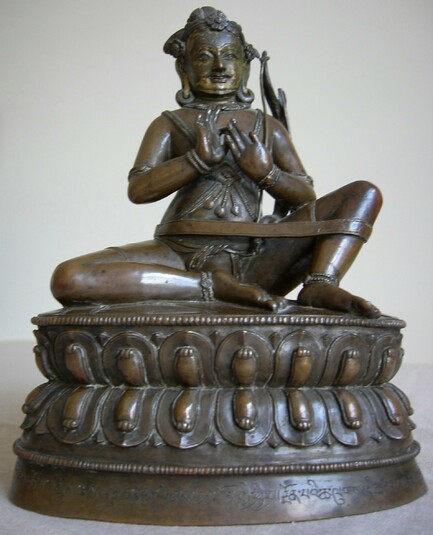
Item: Indian Adept (siddha) - Shavaripa
| Origin Location | Tibet |
|---|---|
| Date Range | 1600 - 1699 |
| Lineages | Sakya, Ngor (Sakya) and Buddhist |
| Material | Metal |
| Collection | Katimari Collection |
Classification: Person
TBRC: bdr:P3277
Shavaripa: The Hunter, he was one of the most important siddhas from the group of the famous Eighty-four Mahasiddhas. This sculpture belongs to a large set of figures depicting the Chakrasamvara lineage according to the Sakya Tradition of Tibet. The full set of sculpture were originally kept at the Ngor Ewam Monastery where the majority of the set remains today. (See Shavaripa Main Page and see two additional sculpture from the set).
Chakrasamvara Lineage, Abisheka, Root Tantra and Commentary: Vajradhara, Vajrapani, Maha Brahmin Saraha, Acharya Nagarjuna, The Protector Shavari, Luipa, Darikapa, Vajra Ghantapa, Kumarapada, Jalandharapa, Krishnapa, Guhyapa, Nampar Gyalwai Shap, The Acharya Barmai Lobpon, Tilopa, Naropa, (the two) Pamtingpa Kuche Nyi, Lama Lokkya Sherab Tseg, Lama Mal Lotsawa, The Lord of Dharma Sakyapa (1092-1158). (Sakya Lineages).
Shavaripa Hagiography:
"On the rugged slopes of Vikrama Peak Mountain there lived a man named Shavaripa. A hunter by occupation, Shavaripa's very survival relied on taking the lives of forest animals. Although he was good man, his ceaseless killing had caused him to accumulate a great deal of bad karma.
Witnessing Shavaripa's situation and feeling pity, the Buddha of Compassion, Avalokiteshvara, took human form and descended to the mountains. The Bodhisattva disguised himself as another hunter and boasted to Shavaripa that he could shoot one hundred deer with a single arrow. Naturally, Shavaripa did not believe him and challenged him to try. The next day, the two went to a clearing where they found a herd of deer that Avalokiteshvara had conjured forth with his magical powers. To Shavaripa's surprise, the Bodhisattva killed exactly one hundred deer with only one arrow shot as he had claimed he would. Awestruck, Shavaripa begged the Bodhisattva to teach him this most impressive hunting skill. The Bodhisattva responded that he would, but that there would be a condition. The condition was that Shavaripa and his wife had to refrain from eating meat for an entire month. The couple eagerly agreed.
After one week the Bodhisattva returned and happily saw that the couple was still adhering to the condition, and decided it was appropriate to give Shavaripa and his wife further instruction. The Bodhisattva explained that for the rest of the month they were to contemplate loving kindness towards all living things. When the month had past, Avalokiteshvara returned and immediately drew a mandala, a sacred diagram, on the ground in front of the couple.
When the couple looked upon it, they saw themselves at its center, writhing and burning in hell. The Bodhisattva then began to explain basic Buddhist principles such as the effects of virtuous and unvirtuous actions, and how the long term effect of taking life is birth in a human hell. He explained to the couple that by renouncing their wicked acts they could avoid ending up in such a place. He then gave the hunter a meditation practice.
Shavaripa practiced meditation in the mountains for twelve years until he attained supreme realization. He then spent the rest of his life as a teacher in his home country, instructing countless students on the path to liberation."
Monty McKeever 3-2006
Sculpture: Tsang Province Atelier (Teachers)
Sculpture: Tsang Atelier (Inscriptions)
Sculpture Set: Mahasiddhas (Tsang Atelier, Various Lineages)
Sculpture: Tsang Atelier Masterworks
Indian Adept: Shavaripa Page
Collection of Katimari
Sculpture: Figurative Subjects, Double Lotus Base
Sculpture: Tsang Province Atelier, Tibet
Sculpture: Tsang Province Atelier (Mahasiddhas)
Indian Adept: Shavaripa Masterworks
Indian Adept: Shavaripa Biography

